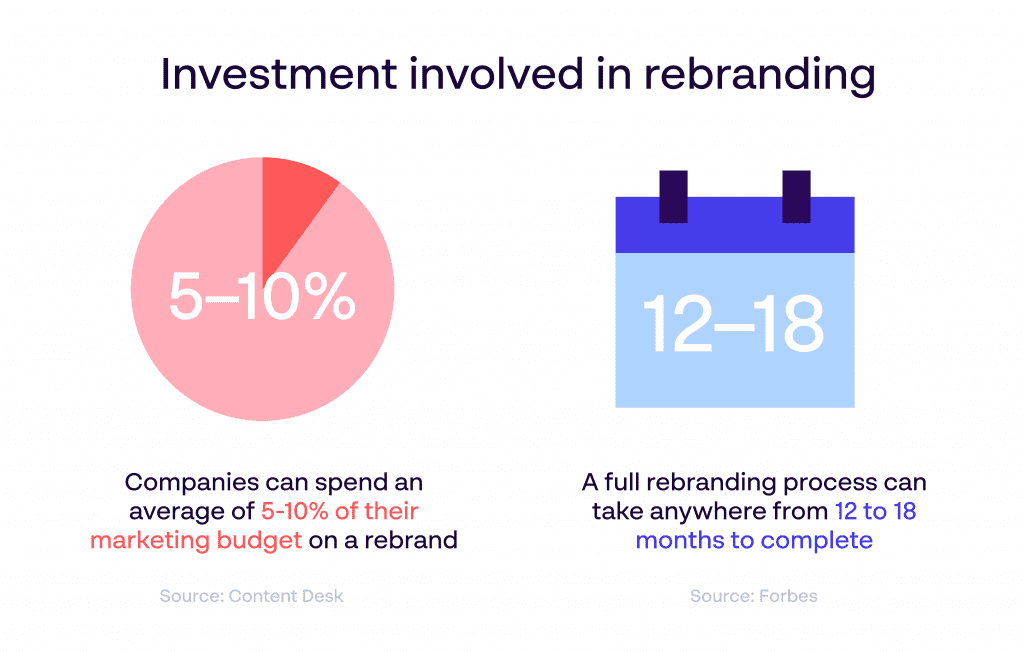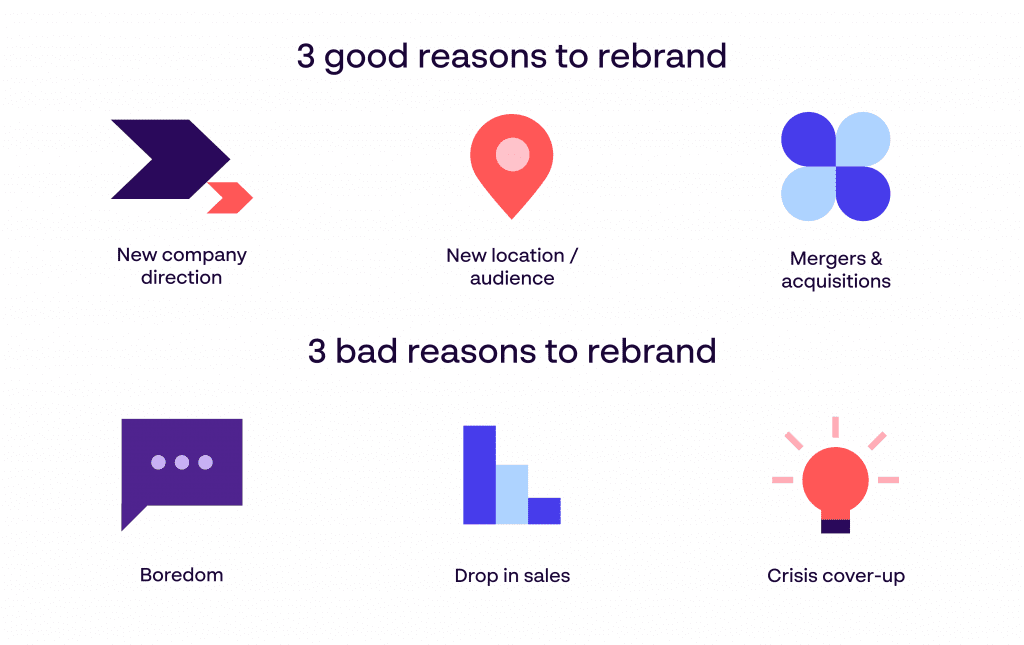“To improve is to change; to be perfect is to change often.”
Churchill said this in response to criticisms that he changed political parties. Great leaders are both courageous and vulnerable. They reflect on their strengths and weaknesses, and course correct – sometimes in very public ways – to ensure their behaviours match their values and goals, even when it’s not easy.
We all grow and change over time… and so do brands. Whether in response to a new line of products and services, an evolution in visual identity, or to reflect a shift in a company’s mission and values, a rebrand can keep an organisation aligned with an ever-changing landscape.
However, this is not a step that should be taken lightly. The cost of rebranding a business can be a steep one if the purpose of this change and the approach to this problem is not carefully considered. Not only can it cost you a serious amount of time and money, but your company’s reputation could be at stake if you miss the mark.

What is rebranding?
Rebranding is an exercise in changing or improving any major branding elements e.g. logo, colour palette, typography, etc. The idea behind it is that a brand is evolving, and the company wants people to know about it.
A business can rebrand as much or as little as it wants, from simply changing its slogan or logo, to changing everything, including the company name. It’s helpful to consider three different types of rebranding:
- Brand refresh – You change minor details only, such as modernising individual aspects of your logo or slightly changing the hues of your colour palette.
- Partial rebrand – You change certain elements but not others, such as using a new logo that uses elements, themes and colours from your old logo.
- Full rebrand – You change everything as if you were a completely different company.
Whichever approach most appeals to your current circumstances, it is important that the purpose of your rebrand is carefully considered. History is littered with rebranding examples that had far from ideal outcomes:
- Tropicana’s simplification of its logo and packaging ended up costing the company a 20% loss in sales
- Pepsi paid $1 million to update a logo that alienated many of their loyal customers
- Gap’s rebranding attempt that was so roundly rejected by their customers it was reversed just days afterwards
These examples are not to say that rebranding a company isn’t a wise decision – given the right circumstances, a new look and feel can be a significant asset to a brand. Perhaps your existing image is lagging behind the times visually, meaning you are coming across as old-fashioned or limiting your chances of capturing a new audience. Or you reimagined your company’s objectives and values and want to reflect them outwardly.
In other words, it is crucial to carefully consider the reasons behind your rebrand, and weigh up whether this investment can benefit the business or not…
3 good and 3 bad rebranding considerations
Your motivations behind a brand change are vitally important to look upon with a critical eye. Due to the seismic shift a full-scale corporate rebrand could have on your organisation’s image, your relationship with your customers and more, it is vital that one is pursued for the right reasons.
Below, we give a quick breakdown of three worthwhile reasons to start the rebranding process, and three that might require a rethink:

Good reason #1: New company direction
Over time, the mission, vision and values of your company may have shifted to the point of being unrecognisable to what they were originally. Whether as a result of new market conditions, a change in senior management, or simply natural evolution, your brand identity may need to be freshened up or changed entirely to reflect your new direction.
Bad reason #1: Boredom with current identity
Just because you may have fallen out of love with your existing branding doesn’t mean your customers have. It is important to separate your own feelings from what your brand is meant to do – appeal to your target audiences. Making a change due to your own disillusionment could have major ramifications to your company’s future
Good reason #2: Reaching a new region or audience
Whether you are expanding to another part of the country or around the globe, or you have shifted focus to a new target audience, you might need to refresh your brand in order to better appeal to these customers. Alternatively, in the case of venturing abroad, you may consider adopting a ‘sister brand’ that aligns more closely to the culture you are entering.
Bad reason #2: A dip in sales
A recent reduction in revenue could be an indicator of many things, not just that people are bored with your brand. When Uber updated their brand a few years ago, half of their customers surveyed had no idea what their new logo represented. Instead of making this hasty decision, take the time to consider if other areas of your marketing strategy or overall business could account for this loss of sales.
Good reason #3: Mergers and acquisitions
If you find yourself in the situation of having joined forces with one or more additional companies, it can be beneficial to bring relevant elements of all brands involved into one united identity that previous customers of all sides (and future customers) can familiarise themselves with.
Bad reason #3: Covering up a crisis
While it might feel like a wise decision to rise from the ashes of a PR disaster as a completely different brand, today’s savvy consumers can see right through these attempts. This can actually exacerbate the crisis, making people feel you are trying to take the easy way out rather than owning up to and learning from your mistakes.
Added to this, you may have to convince important stakeholders in your organisation to opt for a rebrand. Make sure that you are well prepared by setting out any arguments clearly and draw up a strategy to help you make a decision that is fully supported by all parties.
Tips to prepare for your corporate rebrand
Once you have established your reasons for pursuing a rebrand are appropriate, a brand refresh rollout plan will involve several significant steps to best ensure a successful result.
Identify your company’s vision, mission and values
Start by reaffirming in your mind what your company stands for today, and how that differs from where you were when your current branding was introduced. How have your values shifted? Do you have new objectives and targets? By devoting time to this topic you’ll have a stronger sense of where your identity needs to evolve and in what direction.
Audit existing brand assets
You don’t necessarily need to reinvent the wheel to refresh your brand. Rather than start from scratch, look at your existing assets and see what can be salvaged. What still aligns with the new direction you wish to take your brand, and what needs to be reimagined?
These expressions of your existing brand will be indispensable for your team – only by understanding where your brand is now can you effectively plan for its future.
Secure buy-in from key stakeholders
Leadership. Employees. Customers. Shareholders. There are a lot of groups that you will need to convince in order to make your rebrand a success, so it is valuable to canvass their opinions and prepare them for the change that you intend to make.
Once you have their support, the chances of a good outcome greatly improve than if you were to spring the ideas or change onto them without any warning. It will also give you valuable insight into whether your rebrand would be accepted and if it is necessary.
Build the right team
A rebrand must be a collaborative effort across your team in order to make the move stick and to ensure the final product does not alienate employees. Get representatives from across your senior management, marketing, sales, human resources and further departments involved who can actively lend their insight into repositioning your brand.
Get ready to update brand guidelines
As the key documentation at the crux of your brand identity, it is important that you are ready to update your brand guidelines with the new visuals, colour palettes, verbiage and more that will underpin your new direction.
Furthermore, storing this valuable information in a digital brand portal could be crucial in ensuring that everyone in your team is aware of the change, limiting the potential for any of your previous brand assets resurfacing later on.
Plan a successful launch
Consider how you will intend to make the world aware of your new direction. You may want to tease the arrival of your rebrand through a social media or email marketing campaign, getting people excited about the arrival rather than springing it on the unaware.
Or, maybe you feel an out-of-nowhere advert or website update will have a more eye-grabbing effect. A classic example of this is the Old Spice viral campaign that absolutely catapulted the previously old-fashioned brand into the next generation.
Of course, there is so much that must be taken into account for a rebranding strategy to work as intended. If you’d like to know more, download our essential guide to rebranding below.

Are you ready for a rebrand?
Whether you are opting for a light refresh of your brand visuals and messaging, or a complete brand overhaul that pushes your company towards a bright new tomorrow, it is essential to have the tools alongside you to accommodate this massive shift.
Papirfly’s all-in-one brand management platform offers a powerful selection of features that can help ease the process of rebranding and ensure that the results stick across your future marketing campaigns.
- Use the template studio to bring asset creation in-house, locking down the key elements of your new branding so all assets produced are perfectly consistent
- Keep all up-to-date brand assets in the in-built DAM system, preventing outdated logos and obsolete branding from re-emerging
- Coordinate the steps involved in your rebrand with birds-eye campaign planning
- Introduce an online, accessible brand portal to act as a single source of truth for all your brand now represents
Discover the efficient, consistent and exciting future of marketing – get in touch to learn more about our brand management solution or book a free demo today.




